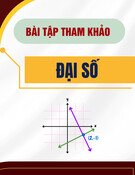
Journal of Mining and Earth Sciences, Vol 65, Issue 6 (2024) 1 - 10 1
Solutions to improving the efficiency of production
organization at semi-mechanized longwall face I-6-2,
Bac Quang Loi coal mine
Dung Tien Thai Vu 1,*, Khai Cao Nguyen 1, Phuc Quang Le 1, Luong Xuan Nguyen 2
1 Hanoi University of Mining and Geology, Hanoi, Vietnam
2 Dong Bac Corporation, Quangninh, Vietnam
ARTICLE INFO
ABSTRACT
Article history:
Received 30th May 2024
Revised 19th Sept. 2024
Accepted 14th Oct. 2024
Dong Bac Corporation is the second largest coal producer in Vietnam with
output accounting for more than 14% of the country's total production.
According to the plan, coal production from underground mines is expected
to increase to 60% of the total Corporation’s production by 2025. To increase
coal production in longwall mining, Dong Bac Corporation applies advanced
technological solutions to modernize production stages, with the notable
implementation of the semi-mechanized longwall mining technology. This
technology uses a single-drum shearer and mobile hydraulic supports. The
use of the technology has encountered challenges and difficulties, resulting in
low production efficiency. The highest output achieved in the longwall face
only reached 70% of the initial design capacity. The article presents the
current status of technological innovation in underground coal mining of
Dong Bac Corporation. The primary research subject is the semi-mechanized
longwall face I-6-2 at Bac Quang Loi coal mine of Company 790, Dong Bac
Corporation. Based on analysing the causes of difficulties, the authors provide
solutions to improving production efficiency, safety, and the environment.
Some solutions have been used in practice and have achieved positive and
promising effects. Adjustment of production cycle organization chart to align
with mining conditions has resulted in an increase in effective working time
and a 17% rise in coal output. Accordingly, the authors propose technological
orientations for the development of underground coal mining at Dong Bac
Corporation.
Copyright © 2024 Hanoi University of Mining and Geology. All rights reserved.
Keywords:
Effective working time,
Face stability,
Mine pressure,
Organizational chart,
Semi-mechanized longwall.
_____________________
*Corresponding author
E - mail: vuthaitiendung@humg.edu.vn
DOI: 10.46326/JMES.2024.65(6).01

2 Dung Tien Thai Vu et al./Journal of Mining and Earth Sciences 65 (6), 1 - 10
1. Introduction
In 2023, Vietnam produced 46 million tons of
raw coal for different domestic and foreign
demands. The two major parties, Vietnam
National Coal - Mineral Industries Holding
Corporation Limited (Vinacomin) contributed 39
million tons (accounting for 84.8%), and Dong Bac
Corporation (DBC) - 6.66 million tons (accounting
for 14.5%).
The underground coal production of DBC in
2023 took up 42% of the corporation’s total
output (2.82 million tons). According to the plan,
this ratio is expected to increase to 60% by 2025
and will reach 72% (5.45 million tons) by 2030.
Thus, in 7 years, the underground coal output of
DBC should nearly double. To achieve this, the use
of new technology to increase productivity and
coal surface output is inevitable. This is the
direction to contribute to the sustainable
development of DBC’s underground coal mining
industry.
In general, the geological conditions of coal
mines in Vietnam, especially underground mines
are quite complicated. This is characterized by the
large variations in thickness, slope angle of coal
seams and the appearance of faults with large size
and displacement amplitude.
Unlike Vinacomin, DBC is assigned to manage
and exploit small coal mines. They are dispersedly
distributed in the boundary areas of the Northeast
coal basin. These coal mines of small size and
modest reserves are located far away from each
other and have more complex geological
conditions than the coal mines of Vinacomin.
Operating conditions of DBC's coal mines are
more difficult because DBC is an agency of the
Department of Defense.
Because of the complicated geological
conditions as well as limited capital investment,
DBC's underground coal mines are using rather
obsolete technologies. Most coal mines use
drilling and blasting technology with hydraulic
props. Since 2019, DBC has put into practice a
shearer at the longwall face 10.2T at Nam Khe
Tam mine (Vu et al., 2021). The actual deployment
process encountered many difficulties due to the
novelty of technology for workers and the
inadequacy of combining hydraulic props with
shearers (Vu & Do, 2019).
From the acquired experience, from 2022,
DBC has implemented a new step in the
modernization of the coal mining process.
Longwall face I-6-2 is designed for the use of
mobile hydraulic supports and shearers (IMSAT,
2021). Significant improvements have been noted
when compared to a longwall face with hydraulic
props. However, in actual production, some
problems caused the longwall face to not work as
expected. Of note is the disparity in production
organization between reality and design, which
extends the production cycle. Furthermore, the
variation in properties of the floor, coal face, and
roof negatively affects the working space and
slows down face advancing speed.
This paper proposes several solutions to
addressing unfavourable issues and improving
production efficiency for the semi-mechanized
longwall face I-6-2. It primarily focuses on the
development of a rational production
organization chart.
2. Data and research methods
2.1. Research methods
In this paper, the data of the research were
collected through a practical survey process.
From these data, the authors analyzed the existing
issues. Through theoretical research and analysis,
the authors proposed appropriate and highly
feasible solutions. The effectiveness of these
solutions was verified through the results
achieved in practical production.
2.2. Current status of semi-mechanized
longwall face I-6-2
2.2.1. Design parameters
The longwall face I-6-2 uses a shearer to cut
coal in combination with mobile hydraulic
supports. This is the DBC's most technologically
advanced longwall face. This coalface is currently
operating in the area of seam 6, Bac Quang Loi coal
mine of Company 790. In the mining area, the
immediate roof and floor have low to medium
stability. The main roof consists of siltstone and
sandstone with a thickness of 5.4÷7.4 m and is
from stable to very stable.

Dung Tien Thai Vu et al./Journal of Mining and Earth Sciences 65 (6), 1 - 10 3
The semi-mechanized longwall face I-6-2
uses the longwall top coal caving (LTCC) method.
The longwall face is supported by mobile
hydraulic support GTL1600/16/24MK, extracted
by a single-ended ranging drum shearer
MG125/150-WD. The mined coal is transported
by scraper conveyor SGZ630/2x90 (Figure 1).
Basic design specifications of the longwall
face I-6-2 are shown in Table 1.
The main part of the longwall face is 50m long
and is extracted by shearer MG125/150-WD with
a cutting drum diameter of 1.3 m. The coalface
height is 2.2 m. The process of cutting coalface is
divided into two stages (Figure 2):
No
Indices
Units
Values
1
The average thickness of coal seam
m
3.6
2
Average slope angle of coal seam
degree
16
3
Cutting height
m
2.2
4
Recovered coal layer
m
1.4
5
Longwall face length
m
60
6
Number of production cycles per day
cycle
3
7
Face advancing speed
m/day
2.4
8
Capacity of longwall face
T/year
150,000
9
Number of workers per day
worker
63
10
Direct labor productivity
T/ labor
9.2
Figure 1. Main equipment of the longwall face I-6-2.
Table 1. Economic and technical indices of the longwall face I-6-2 by design (IMSAT, 2021).
Figure 2. Organizational chart of the production cycle of longwall face I-6-2 by design.

4 Dung Tien Thai Vu et al./Journal of Mining and Earth Sciences 65 (6), 1 - 10
(1) Shearer cuts the upper part of longwall
face (s1), support lifts the shield to temporarily
hold the cut face (p1);
(2) Shearer cuts the lower part of the
longwall face (s2), and moves conveyor (c) and
mobile hydraulic supports (p2) to a new position
according to the cutting progress.
Due to the use of a downward-facing single-
ended ranging drum shearer, the front end of the
longwall face, which is adjacent to the ventilation
roadway and has a length of xp = 10 m, is created
by drilling (d) and blasting (b). In this area, the
shearer moves in an unloaded state (s0).
The total movement time of the system
"shearer - conveyor - support" is:
𝑇=∑𝑡𝑖
6
𝑖=1 ,𝑚𝑖𝑛
(1)
According to the calculation of the original
design, the time to complete a production cycle of
the longwall face I-6-2 is one shift (8 hours). A
cutting depth of 0.8 m allows the coalface to move
2.4 m per day.
2.2.2. Some problems encountered in practice
During its operation, semi-mechanized
longwall face I-6-2 had a few problems that made
it difficult for production activities. Some typical
problems include:
(1) Organisation of production is widely
different from the design. The arrangement and
implementation of the process have not been as
effective as expected. Therefore, the time to
complete the production cycle of the longwall face
is prolonged, reducing productivity and output. In
one day, only 02 production cycles can be
completed (compared to 03 cycles per day by
design) which leads to a decrease in output. The
actual output of the longwall face is 275÷363
tons/day, corresponding to the highest converted
output of 108,900 tons/year.
(2) Face spall occurs at some locations at
some time. This has a direct negative effect on the
workspace and stability of the longwall face.
(3) In some locations, an unstable floor
makes the supports prone to heave, which slows
down the face advancing speed.
2.2.3. Reviews and analysis
Supports in the longwall face are mobile
hydraulic supports. This type is not too new for
the underground coal mining industry in Vietnam.
However, for underground coal mines of Dong
Bac Corporation, this can be considered as the
most advanced type of support to be put into use.
At semi-mechanized longwall face I-6-2, the
movement of mobile hydraulic supports was a big
problem for workers. Currently, the time to fully
move mobile hydraulic support according to face
advancing speed is 15 minutes/support. In some
adverse cases, movement time can be up to 25÷30
minutes/support.
In the initial production organizational chart,
mobile hydraulic supports are moved along with
the movement of the shearer and conveyor with a
minimum distance of 10 m from the shearer's
operating position (see Figure 2, s2 and p2). With a
cutting speed along the longwall face of 1.0÷1.5
m/min, the moving speed of supports is designed
with synchronous speed, corresponding to
1.5÷2.0 min/support. Thus, the difference
between the actual moving speed and design is
substantial. That is, the actual time t2 is much
larger than the original calculation. The main
causes of this problem include:
(1) Technical competencies of workers:
Although mobile hydraulic supports are a
familiar form of support in Vinacomin
underground coal mines, this can be considered
the most advanced form of support in DBC's coal
mines, including the Bac Quang Loi coal mine.
Currently, in DBC's underground coal mines, the
most common type of used supports is hydraulic
props.
Because of the short exposure and working
time with mobile hydraulic supports, workers are
still confused and do not have the necessary
experience to master the operation. The
immaturity when moving supports makes the
operation time significantly longer.
(2) Influence of mining technical factors:
The size of mobile hydraulic support is
significantly larger than that of conventional
hydraulic props because it is composed of two
beams. However, the movement is performed in
turn on each side. That is, moving mobile
hydraulic support can be considered as moving
02 combinations of the hydraulic prop with the
box beam. Therefore, the state and connection

Dung Tien Thai Vu et al./Journal of Mining and Earth Sciences 65 (6), 1 - 10 5
between the two sides of support are very
important in mine pressure control.
Under unfavorable geological conditions,
stress concentrations often appear and cause
negative effects on supports (Le & Mai, 2022).
This makes it difficult to move the mobile
hydraulic supports due to stress imbalance.
Besides, during the operation, when the coal
face is not supported in time, a face spall occurs.
This can happen on a local scale with a small area
but still has a negative impact on other activities
in the workspace. When the coal face is damaged,
additional hydraulic props are required (Figure
3).
The main causes of these problems are:
(1) Variation in properties of coal and rock
(Le et al., 2020);
(2) Mobile hydraulic supports do not
guarantee the ability to completely cover the roof
area of the coalface. There is always a certain
space between supports, and between them and
coalface. Typically, when the shields do not
contact with the roof and longwall face (Figure 4),
face spall can occur.
(3) Face advancing speed is slow due to many
different factors, especially the prolonged
movement of hydraulic supports. When coalface
is in a spatial position for a long time, the
"weariness" of the top coal and roof will increase
due to mine pressure (Le et al., 2019). The mine
pressure value, in this case, is inversely related to
face advancing speed. As a result, longwall faces
with slow advancing speed should be more prone
to face spalling. In some locations, unstable floor
is the cause of heave problems. Local heave of the
floor affects the operation of mobile hydraulic
supports. Supports can be shortened, tilted or
deflected. Generally, the connection of each
individual mobile hydraulic support at the face is
reduced. Large deviations in support position
make it difficult to move.
In general, when facing unfavorable factors of
mining technical conditions, hydraulic supports
operate passively along with different stress
distributions. Operation time of support therefore
also increases significantly. The extended time of
moving supports directly affects the performance
of other stages in the production cycle (Nguyen et
al., 2020). Therefore, the organizational chart of
the initial production cycle of longwall face I-6-2
does not match reality.
3. Solutions to the improvement of production
efficiency at the semi-mechanized longwall
face I-6-2
Based on the above analyses, semi-
mechanized longwall face I-6-2 has operated
inefficiently mainly due to the prolonged
movement of supports and the unreasonable
organization of production. This problem has
existed since the commencement of the face. In
theory, this problem can be solved by adopting
more advanced, modern, and suitable equipment.
However, due to limitations in human resources
and investment capital, it is not feasible to
modernize equipment for DBC at present. It is
necessary to have specific and practical technical
solutions to overcome the above problems.
Figure 3. Additional support by hydraulic props at
the longwall face I-6-2.
Figure 4. Hydraulic supports are not close to coalface
at longwall face I-6-2.




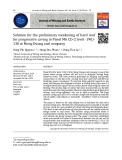
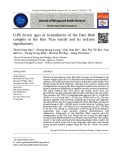

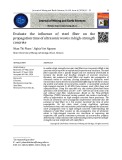


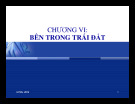






![Bài tập Đại số tuyến tính [chuẩn nhất]](https://cdn.tailieu.vn/images/document/thumbnail/2025/20250930/dkieu2177@gmail.com/135x160/79831759288818.jpg)

